Misyon Online - November-December 2013
Columbans ‘who have gone before us with the sign of faith’ - November 2012 – November 2013
To our departed brothers and sisters
And to all who were pleasing to you
At their passing from this life,
Give kind admittance to your kingdom.
(Eucharistic Prayer II)
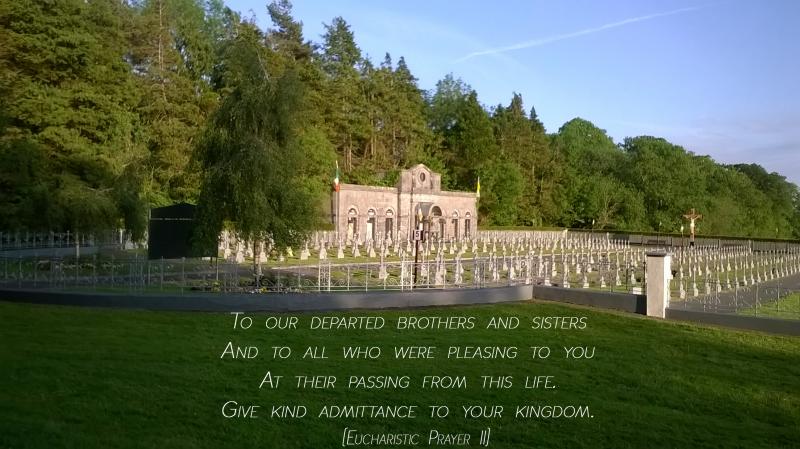
St Columban’s Cemetery, Dalgan Park, Ireland

Two Masses for Deceased Columbans
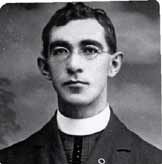
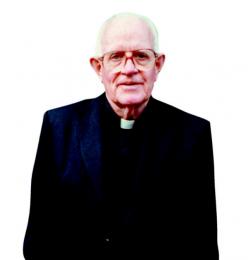 In this issue we feature two Masses celebrated earlier this year here in the Philippines for two deceased Irish Columban priests. One, Fr Timothy Leonard, had never set foot here and died 84 years ago in China, aged 36, the first Columban to die violently. The second, Fr Joseph Gallagher, died peacefully in Ireland at the age of 90, a man who had spent 57 years in the Philippines, most of those in Pangasinan.
In this issue we feature two Masses celebrated earlier this year here in the Philippines for two deceased Irish Columban priests. One, Fr Timothy Leonard, had never set foot here and died 84 years ago in China, aged 36, the first Columban to die violently. The second, Fr Joseph Gallagher, died peacefully in Ireland at the age of 90, a man who had spent 57 years in the Philippines, most of those in Pangasinan.


Memorial Mass For Fr Joseph Gallagher
By Fr Patrick J. Baker
‘He was... a perfect gentleman’. These words from the homily of Bishop Marlo M.
Peralta of Alaminos at a Memorial Mass for the late Fr Joseph Gallagher in Labrador, Pangasinan, echoed what everyone said about Father Joe at his funeral in Ireland, which your editor attended.
Fr Joseph Gallagher died in Ireland on 2 August at the age of 90. He had retired to Ireland in 2006, having spent 57 years in the Philippines, 22 of them in San Isidro Parish, Labrador, formerly part of the Archdiocese of Lingayen-Dagupan but since 1985 part of the Diocese of Alaminos, Pangasinan.

Memorial Mass For Fr Timothy Leonard
By Fr Pat Baker
Fr Timothy Leonard was ordained in 1918 for the Diocese of Limerick, Ireland, and joined the newly-established Society of St Columban that year. He was in the first group of Columbans to be assigned to China in 1920. He worked with Columban Co-founder Fr Edward Galvin for four years in Hanyang where Fr Galvin became the first bishop in 1927. Then he was assigned to Ireland in 1924 for two years of mission appeal work. He became a well-known figure, riding his bicycle from parish to parish in all kinds of weather.
Father Tim returned to Hanyang in 1926 and in 1928 was a member of the first group of Columbans to go to Nancheng where Columban Fr Patrick Cleary became the first bishop in 1938. While saying Mass there on the morning of 17 July 1929 a group of Communist bandits stormed into the church and attacked Fr Leonard. His vestments were torn off him, the ciborium with consecrated hosts was snatched from his hands and the hosts scattered on the floor and trampled on.

Reflection - Suicides in Japan and God's gentleness
By Fr Barry Cairns
Fr Barry Cairns from New Zealand has been a missionary in Japan since 1956. He offers us this reflection, written from the heart, on the tragedy of suicide and the closeness and gentleness of God.

I have just come from a very emotional funeral of a young girl of 18 who committed suicide. I write this after sharing with the distraught parents and realize that I too need to share with someone.
Both parents are indeed devastated. Their sorrow was not only the sadness and loneliness of loss, but also had a background of deep felt guilt.

Death is stark for the poor
By Sr Mary Dillon SSC
The author is a Columban Sister from Ireland. She has been in the Diocese of Myitkyina, Kachin State, Myanmar (Burma) since 2002. She has developed a home care health program for people with HIV/AIDS and established a respite house, Home of Hope, to enable people from distant places to avail of medical care. Here she reflects on her experience of burials in Myanmar.
I was shocked when I read about the costs of funerals in Ireland. An exorbitant sum was quoted, several thousand euro (€1.00 = PHP58.00), even for a simple, ‘no frills’ burial. Many people it seems spend a long time paying off the debt. Others talked of the cost of a grave, the advantages of cremation, the necessity of a wake or a meal after the burial, and so on. It was all very sobering.
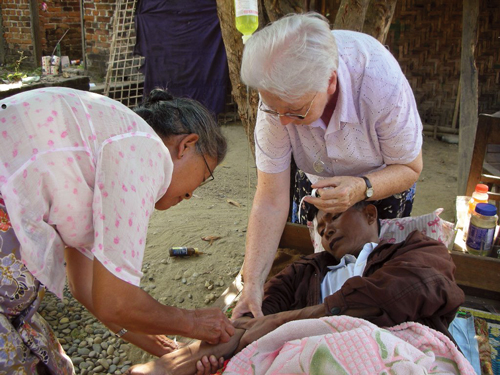
What a contrast to my experience of burials in Myitkyina, Myanmar! For the past nine years here in Myanmar I have been working with the very poor.
In the last year we buried approximately 48 patients from the 30-bed Home of Hope where I am. Most of these, men and women, died of AIDS. The majority had no one to mourn them, no family to grieve at their going.

Some Reflections on the Community at Mass
By Rowena D Cuanico
The author, from Samar, is a former Columban Lay Missionary who served in Fiji and the Philippines. She is a frequent contributor to Misyon and other Columban magazines.
Weng with her Fijian friends
I often go to Mass at a chapel located in a shopping mall in an affluent part of town.
People are dressed nicely in fashionable clothes and shoes, carrying fashionable bags. They come mostly with their families. Some also come with their well-uniformed nannies and caregivers in tow.
Sometimes I would wonder why nannies and caregivers have to wear their uniforms. Is this to set their employers apart and bestow on them some status or prestige? Or is this to distinguish these nannies and caregivers from the rest of the congregation and assign them their place in society? I feel sad that even in a faith community where there should be ‘no more Gentile or Jew, servant or free, woman or man’, you can still identify their positions in society simply because of the uniforms some have to wear. I can't help but wonder, is this how far we still are from the Kingdom of God whose dawning we have come to celebrate?

Pulong ng Editor
Two Masses for Deceased Columbans
In this issue we feature two Masses celebrated earlier this year here in the Philippines for two deceased Irish Columban priests. One, Fr Timothy Leonard, had never set foot here and died 84 years ago in China, aged 36, the first Columban to die violently. The second, Fr Joseph Gallagher, died peacefully in Ireland at the age of 90, a man who had spent 57 years in the Philippines, most of those in Pangasinan.
|
Fr Timothy Leonard (1893 – 1929) |
|---|
Fr Tim Leonard was one of the first Columbans, joining the newly-approved Society of St Columban shortly after his ordination for the Diocese of Limerick, Ireland, in 1918. He was in the first group of Columban priests to go to China, in 1920. While he was celebrating Mass on the morning of 17 July 1929 Communist bandits broke into the church, attacked Father Tim, scattered the consecrated hosts, the Body of Christ, and trampled on them. When he upbraided them they took him outside and hacked him to death.
The occasion for the Mass on Father Tim’s death anniversary, held in the Columban Formation House in Cubao, Quezon City, was the visit of a cousin of the priest, John Leonard. Fittingly, there was a Chinese Columban seminarian present, Peter Dong Lichun.
|
Fr Joseph Gallagher (1923 – 2013) |
|---|
Fr Joe Gallagher died peacefully, surrounded by family members, in the nursing home in St Columban’s, Dalgan Park, Ireland, where he had studied for seven years and where he was ordained in December 1947. The people of San Isidro Parish, Labrador, Pangasinan, where he had spent 22 years, mourned him and organized a special Mass that was celebrated on 25 August. The main celebrant was Bishop Marlo M. Peralta of Alaminos who had met Father Joe only once. The bishop described Father Joe as a holy man who never seemed to get angry, a perfect gentleman, able to relate warmly to everyone in the parish.
‘A perfect gentleman’ was how almost everyone described Father Joe after his death, relatives and fellow Columbans.
In November we remember the dead in a special way. Pope Benedict expressed beautifully why we do this in his homily on 11 November 2005 at the annual Mass for deceased cardinals: ‘For this reason, while we thank God for all the benefits that he has bestowed upon our deceased Brothers, let us offer for them the merits of the passion and death of Christ, so that they may fill the gaps due to human frailty’.
We thank God for those we honor as Columban Martyrs, starting with Fr Tim Leonard, 23 priests and one Columban Sister who died violently while carrying out the mission that Jesus entrusted to his Church. . And for the ‘perfect gentleman’, Fr Joe Gallagher, and the many Columban priests, Sisters and Lay Missionaries who have gone ahead, in the words of Pope Benedict, ‘Let us offer for them the merits of the passion and death of Christ, so that they may fill the gaps due to human frailty . . . Let us invoke the intercession of St Peter and of the Blessed Virgin Mary in order that they welcome them to the Father's house, in the trusting hope that we will one day be able to join them, to enjoy the fullness of life and peace. Amen’.
Columbans ‘who have gone before us with the sign of faith’ - November 2012 – November 2013
Memorial Mass For Fr Joseph Gallagher
By Fr Patrick J. Baker
‘He was . . . a perfect gentleman’. These words from the homily of Bishop Marlo M.
Fr Joseph Gallagher (1923 – 2013)Peralta of Alaminos at a Memorial Mass for the late Fr Joseph Gallagher in Labrador, Pangasinan, echoed what everyone said about Father Joe at his funeral in Ireland, which your editor attended.
Fr Joseph Gallagher died in Ireland on 2 August at the age of 90. He had retired to Ireland in 2006, having spent 57 years in the Philippines, 22 of them in San Isidro Parish, Labrador, formerly part of the Archdiocese of Lingayen-Dagupan but since 1985 part of the Diocese of Alaminos, Pangasinan.
One of Father Joe’s greatest services to the parish was to establish a parish school in 1954, St Columban's School, which is still flourishing. It was originally a high school, but for some years now it has had a large elementary department.
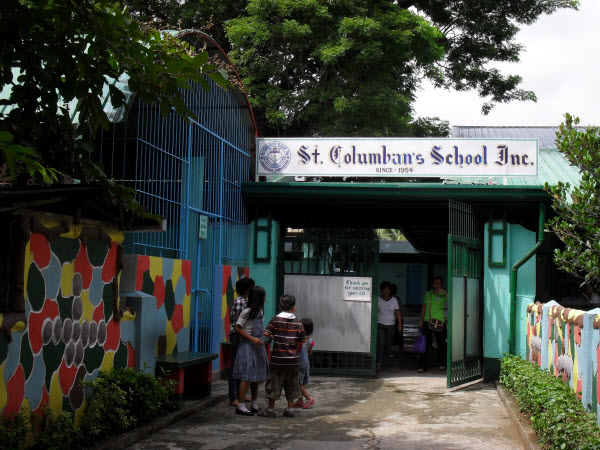

Because he was so dearly loved and remembered in Labrador the community there organized a Memorial Mass for him, celebrated in the parish church on Sunday, 25 August. The idea of having a Mass was first floated by the very active Alumni Association of the school under the presidency of Dra Corazon Macaraeg. But the whole parish wanted to be involved, especially the Parents/Teachers Association, the school, and various parish organizations. It was very obviously a joyful community celebration.
The Columban Fathers and the Columban Sisters were invited to attend. Fr Dan O'Malley, Acting Regional Director at the time, arranged for a group to travel in the van of the Columban Lay Missionaries, with John Din, the coordinator in the Philippines, driving. Four other lay missionaries went along, Arlenne Villahermosa, Nani Mo'unga, Gertrudes Samson and Rosalia Basada. Nani had recently returned from a visit to her homeland, Tonga, while Gertrudes and Rosalia have since returned to Britain for a second term there. Regional Archivist Fr Pat Baker also joined the group.
On arrival in Labrador we were given a very warm welcome by the Sisters of St Joseph of Cluny who have been running St Columban's School since 1996. The Columban Sisters, who had been in charge of the school since 1960, left in 1995. Sr Priscilla (Pricy) George SJC is the present Directress of the school. Originally from India, she has been in the Philippines for eight years. She and her Community and staff provided the Columban visitors with a very substantial breakfast and filled us in on the details of the ceremony about to take place.
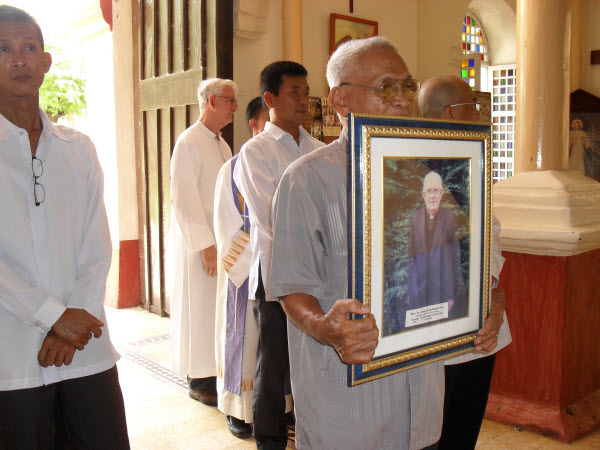
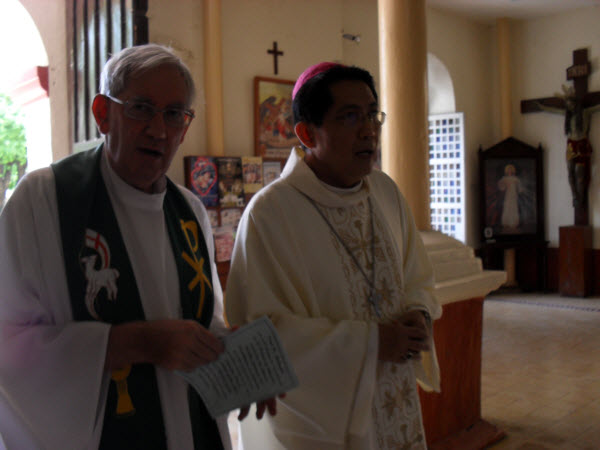 >
>
Bishop Marlo M. Peralta of Alaminos graciously accepted the invitation to be the Main Celebrant for the 10:30 am Mass. Concelebrating with him were the present Parish Priest, Fr Mariolito S. Ferrer, and Fr Isidro R. Palina who had come all the way from Sts Peter and Paul Parish, Calasiao, Archdiocese of Lingayen-Dagupan, because Father Joe had given him a lot of support and encouragement while he was a seminarian. Fathers Dan and Pat also concelebrated.
It was obvious that a lot of preparation had been made for the Mass. There was a big tarpaulin in front of the altar with a photo of Father Joe and some details of his life. Mr Primitivo Rico, the first teacher hired by Father Joe in 1954, carried a large, framed photo of him in the Entrance Procession. The church was full. The Mass was a joyful Mass for the Dead, even though it was a Sunday, a celebration of Father Joe's long life and a prayer that he now enjoy eternal rest.

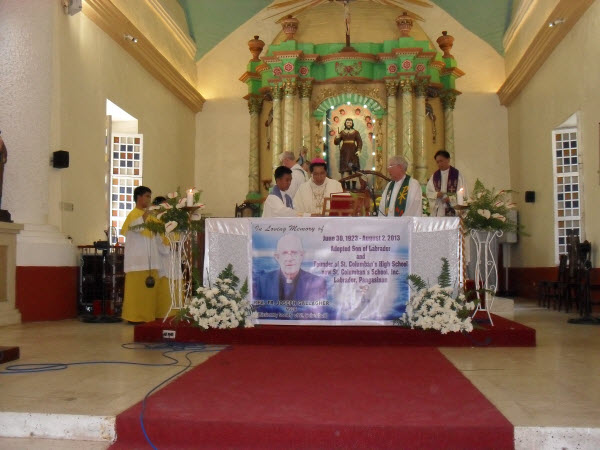
In his homily, Bishop Peralta explained that he was not yet Bishop of Alaminos when Father Joe left Labrador, but that he had met him once. He had made a special trip from Urdaneta Diocese, where he was the Vicar General, to meet him. He had heard what a wonderful priest he was. Father Joe made a lasting impression on him with his warm welcome, his openness, his kindness. The Bishop went on to elaborate on Father Joe's reputation for kindness and generosity towards all whom he met. He was a holy man who never seemed to get angry, a perfect gentleman, able to relate warmly to everyone in the parish, an inspiration to the Bishop and to many others.
Before the final blessing Mrs Lilia Ocampo gave a eulogy about Father Joe on behalf of the Alumni Association. She was a member of the very first graduating class of St Columban's School in 1958. Her sharing made it very clear what an impression Father Joe had made on the students in those early days, what an inspiration he was. The values that he instilled in the students and staff are still a feature of the school. The fact that the Alumni Association is still so active is a testimony of this.
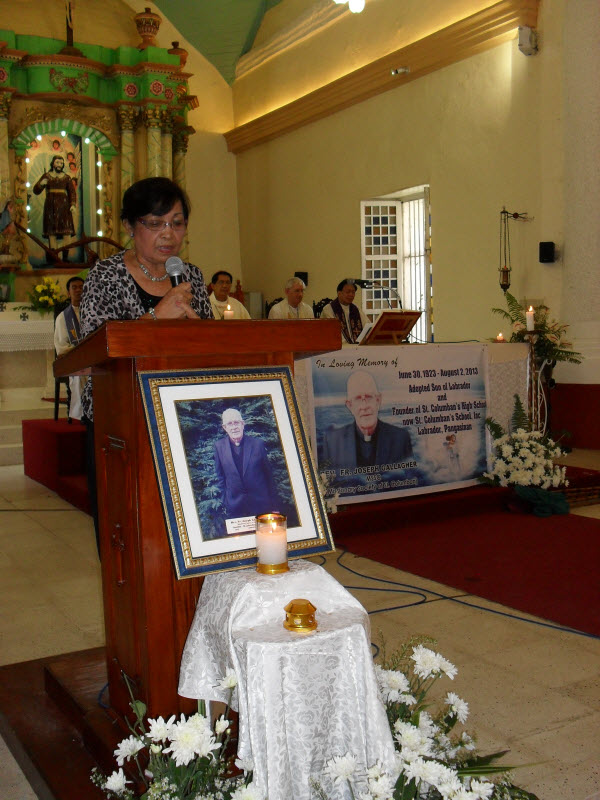
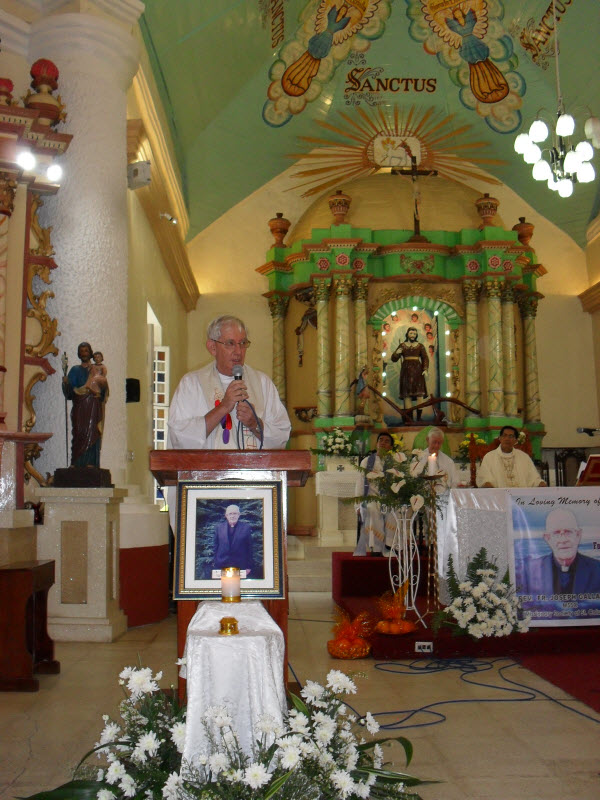
Fr Dan O'Malley was then invited to say a few words on behalf of the Columbans. After thanking the organizers for the invitation and commending them on a very moving celebration, he mentioned that it was appropriate to include Sr Armada Martin SSC in the celebration. She was the last Columban Sister to be involved in the school when it was handed over in 1995. She died unexpectedly on 21 July in San Juan City, only 12 days before Father Joe.
After the Mass lunch was served, provided by generous parishioners and various organizations.
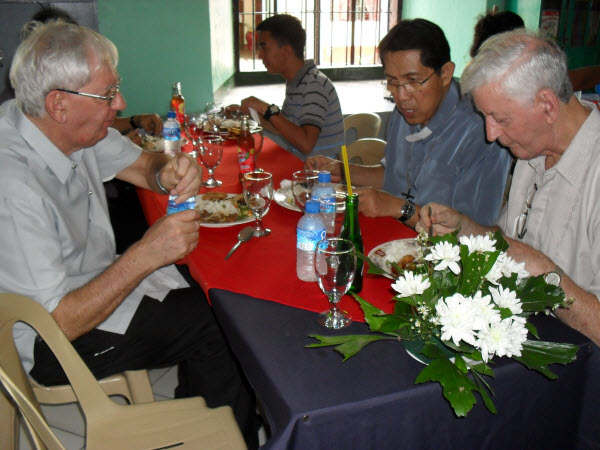
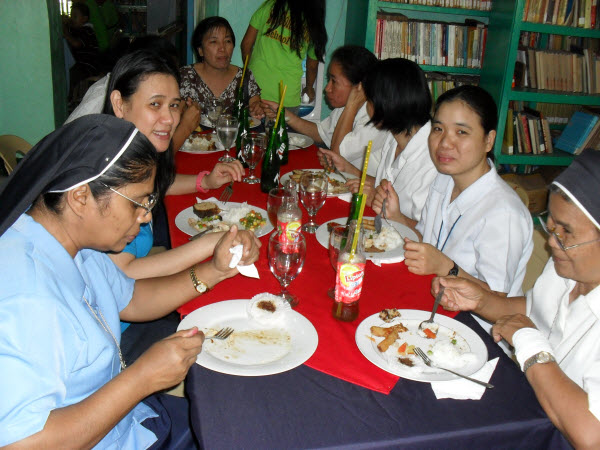
We Columbans came away with a great sense of pride in what Father Joe's presence had meant to the people of Labrador and also with a sense of challenge to try to imitate his kindness, his dedication and commitment to his ministry.
Memorial Mass For Fr Timothy Leonard
By Fr Pat Baker
|
|
|---|
Fr Timothy Leonard was ordained in 1918 for the Diocese of Limerick, Ireland, and joined the newly-established Society of St Columban that year. He was in the first group of Columbans to be assigned to China in 1920. He worked with Columban Co-founder Fr Edward Galvin for four years in Hanyang where Fr Galvin became the first bishop in 1927. Then he was assigned to Ireland in 1924 for two years of mission appeal work. He became a well-known figure, riding his bicycle from parish to parish in all kinds of weather.
Father Tim returned to Hanyang in 1926 and in 1928 was a member of the first group of Columbans to go to Nancheng where Columban Fr Patrick Cleary became the first bishop in 1938. While saying Mass there on the morning of 17 July 1929 a group of Communist bandits stormed into the church and attacked Fr Leonard. His vestments were torn off him, the ciborium with consecrated hosts was snatched from his hands and the hosts scattered on the floor and trampled on.
Father Tim was a big, strong but normally gentle man. Seeing this terrible sacrilege, he upbraided the bandits. One of them smashed him in the mouth, then he was dragged bleeding outside. He was thrown to the ground and hacked to death. His head was nearly severed. He was the first Columban to be killed in China. His death was a terrible shock to all the Columbans in China and elsewhere, as well as to all the Chinese who knew him.
A cousin of the Columban priest, John Leonard, had details about Father Tim’s original burial place and wanted to arrange a more suitable place.
John had come to the Philippines in July this year to visit the graves of two Columbans on behalf of their families whom he knew in Ireland. One was Fr John O'Brien, also from County Limerick, who died in a motorcycle accident in 1950, aged only 26 and who is buried in Olongapo City, and Fr Rufus Halley, murdered in 2001 in Lanao del Sur and buried in Cagayan de Oro City, Mindanao.
John Leonard alerted Fr Dan O'Malley, Acting Regional Director at the time and also from Limerick, that 17 July would be the 84th anniversary of the death of Father Tim. John said that he would like to attend the Community Mass on that day, if possible. He would be willing to share some background on Father Tim, his early days in Limerick and in China. John has gone to a lot of trouble to locate the original burial place and to have the remains transferred to a more suitable site with a Celtic cross and an engraved marble slab with details.
Because we had two students from China in our Formation House in Cubao, Quezon City, Father Dan suggested we might have the Mass there. It was arranged for 6:30 pm on Thursday 17 July. Father Dan was the main celebrant, assisted by Fr Raymond Husband, Rector of Formation. The ten students were present, plus some Columban Missionaries and Columban Sisters. One of them, Sr Mary Ita O'Brien, is from Limerick.
John shared very eloquently about Father Tim. It was a moving experience for all present to feel such a close connection with this first Columban martyr and with the other Columban pioneers in China. It was good for the two Chinese students to hear this story as it helped them to understand why we still have such a passion for mission in China.
Much informal sharing took place during the dinner that was served by the Formation House staff after the Mass. Then we were shown a ten-minute DVD with some historical footage of the very early days in China. Father Tim appeared in one short clip, getting into a rickshaw.
Reflection - Suicides in Japan and God's gentleness
By Fr Barry Cairns
Fr Barry Cairns from New Zealand has been a Columban missionary in Japan since 1956. He offers us this reflection, written from the heart, on the tragedy of suicide and the closeness and gentleness of God.
I have just come from a very emotional funeral of a young girl of 18 who committed suicide. I write this after sharing with the distraught parents and realize that I too need to share with someone.

Both parents are indeed devastated. Their sorrow was not only the sadness and loneliness of loss, but also had a background of deep felt guilt.’
 "Could we have prevented our daughter's death? Should we have listened more and been more supportive?’
"Could we have prevented our daughter's death? Should we have listened more and been more supportive?’
I feel that these post-event questionings are in so many cases not valid. The parents are very human and did their best with someone already an adult.
I will explain how my personal spiritual life has been affected by suicides. I have come to believe more deeply in God's gentle understanding of the human heart and its frailty, and in his loving-kindness and acceptance. The word in Japanese for this attitude of God towards his frail children is ‘Itsukushimi’.
Sometimes a new and strange word helps to bring back meaning to a much used one. ‘Itsukushimi’ is used in the Japanese Bible and liturgy and is a word full of feeling, atmosphere and nuance. It is used to translate the Hebrew word ‘chesed’.
God's ‘Itsukushimi’ is a combination of gentleness, understanding, love, mercy, compassion, warmth and that wonderful ability to feel with a person. For me ‘Itsukushimi’ is the principle trait of Abba, my Father-God, to each of us, his very frail children. But rather than use words, ‘Itsukushimi’ is seen in the concrete in Jesus, who is divine love in a human heart. Jesus cried in front of the grave of his friend Lazarus. Jesus felt deeply with Lazarus's sisters, Martha and Mary, and cried with them.
Again Jesus reached out in gentleness to the grieving young widowed mother of Naim whose only child had died. Jesus felt with her. The Scriptures have an eternal present tense. We too today have a God who cries with us. That ‘Itsukushimi’
|
||||||||||||||||||||||||||||||||||||||||||||||||||||
|
Suicide rates per 100,000 by year and sex in some countries where Columbans work Most recent year available; as of 2011 [Source: World Health Organization] |
So it is, at funerals, especially of suicides, that I speak of God's understanding and gentleness. I believe myself and tell my people that God's ‘Itsukushimi’ is stronger than human frailty.
In one special case of a schoolteacher mother in her 50s where everyone knew she had taken her own life, I spoke on suicide itself. I borrowed words from the yearly article on suicide by Fr Ronald Rolheiser OMI available on the internet.Nowadays when someone dies of cancer it is publicly mentioned. It is recognized as a sickness which brings death.
So too is the very real sickness of depression which also sometimes brings death. Let us accept it as a sickness. Do not let us go into self-incrimination – ‘If only I did this’.
There are nearly 100 suicides a day in Japan. The sad rate for Australia is six per day and New Zealand has 547 suicides a year. In a Japanese Government report published in April 2012, 30% of Japanese in their 20s have seriously considered committing suicide. But 37% of the total suicides are men in their 60s.
Depression is given as the main cause of suicide including a relatively newly coined Japanese word ‘Karoshi’ which means fatigue from overwork resulting in death.
Debt is the second biggest cause due mainly from the easily borrowed but high interest system of the loan sharks. The recent increase of schoolchildren who have been bullied and committed suicide has received a high profile in the media.
These personal experiences and reports in the media make my mission in Japan more meaningful. The Nobel Laureate Kenzaburo Oe speaking of his own Japanese people has said in an interview: ‘We Japanese are a society that has lost hope’. I consciously try to be Christ's instrument of hope.
At the funeral of a mother who took her own life amidst depression I spoke on God's tender loving kindness - Abba's ‘Itsukushimi’. The son who was an architect student designed his mother's grave stone. In the marble column was engraved deeply just one word, ‘Itsukushimi’.
May God's gentle compassion be engraved deeply in our hearts. Let us share God's ‘Itsukushimi’ with others.
+++
Suicides up in last 20 years in PH, mostly among young – NSO
Some Reflections on the Community at Mass
By Rowena D. Cuanico
The author, from Samar, is a former Columban Lay Missionary who served in Fiji and the Philippines. She is a frequent contributor to Misyon and other Columban magazines.
Weng with her Fijian friends
I often go to Mass at a chapel located in a shopping mall in an affluent part of town.
People are dressed nicely in fashionable clothes and shoes, carrying fashionable bags. They come mostly with their families. Some also come with their well-uniformed nannies and caregivers in tow.
Sometimes I would wonder why nannies and caregivers have to wear their uniforms. Is this to set their employers apart and bestow on them some status or prestige? Or is this to distinguish these nannies and caregivers from the rest of the congregation and assign them their place in society? I feel sad that even in a faith community where there should be ‘no more Gentile or Jew, servant or free, woman or man’, you can still identify their positions in society simply because of the uniforms some have to wear. I can't help but wonder, is this how far we still are from the Kingdom of God whose dawning we have come to celebrate?
I often joke with friends that there are only a few 'natives' like me in the congregation. Of course the 'natives' would include the nannies and caregivers. Most members of the congregation are mestizo or mestiza, either Spanish or Chinese or of mixed heritage. You seldom hear Tagalog spoken. You often hear people talk in English. It is no surprise that the seven Masses on Sundays are all in English – not even one in Tagalog!
Weng during her CLM days
Most of the time I feel odd and strange. Only a road separates the place where I live from the condominiums and exclusive villages. But it is fascinating to recognize how much distance there is between ‘their’ world and mine. Indeed I can truly say that I live on the ‘other’ side. The road marks the great divide.
One recent Sunday, I was seated next to a seemingly nice lady in her early 60s. She came with her family. Her face looked serene and wasn’t heavily made up. She had a pair of diamond earrings and a diamond ring on her finger. The bag she was carrying was of an expensive brand. When seated she placed her bag on her lap. And then when we were singing the Our Father she had her arms outstretched – with the bag on one arm. I didn't know how heavy or light the bag was. But I did wonder if this was about the bag and its contents or the person next to her - me?.
I really felt amused that even in that chapel, where people can see and observe each other, where there are security guards, ah - one can't put one's bag on the pew, even for the few moments it takes to sing the Our Father!
People seem to know each other. They must be neighbors in a condominium or village. They usually talk to each other before and after Mass. Yet in the two years that I have been attending the Eucharist there, nobody has ever spoken to me, except to ask if the seat next to mine is vacant or occupied. But I take comfort in the fact that they do turn their heads around and offer me their blessings of peace.
Why do I go there? It is convenient. It’s just about a ten-minute walk from the house. It is air-conditioned. I don't have to look for the pew nearest the electric fan or bring a fan!
The chapel is very quiet and the sound system very good. You can hear a lot of whispers before the Eucharist. But the chapel suddenly becomes quiet when the bell is rung to signal the beginning of Mass.
If the road is the great divide then the gadgets can be the greatest distractions. Before the Mass you can see them tinkering with these. Despite being reminded that cellular phones should be turned off or put into silent mode, there are still some ‘brave’ souls who defy the reminder.
Children are well-behaved. This can be explained, perhaps, by the fact that before Mass there is an announcement asking parents to make sure their children are quiet and well-behaved. Most often when children start feeling restless or noisy, they are brought outside.
There are times when the choir is good. But I do appreciate the fact that they do join in the congregational singing!
And the most important reason I attend Mass there – the homilies are short and crisp. Most are less than ten minutes, which is a blessing and a relief!
In the nearly two years that I have been attending Mass there, I haven't heard any announcements about prayer meetings or about parish organizations, Couples for Christ, for example. I haven't heard any announcements about talks on issues of national significance. Not even about First Communion or Confirmation.
Ah - it 's nice to come here and not be bothered by other concerns. But I am proud to say that when there is a second collection, for example for catechetical programs of the parish where the mall is located or for relief operations, the people give generously. I seldom hear the sound of coins being put into the collection box. It's almost all bills.
When we pray the Our Father which thankfully is usually sung and in Filipino, I often wonder what does 'daily bread' truly mean and what does it signify for them and for me. Here's my thoughts on their 'daily bread ' and mine.
| Theirs. | Mine |
| Whole wheat bread | White bread |
| Rye bread | Pandesal |
| Organic brown rice. | White@37/kg |
| Muscovado. | Brown sugar |
| Olive oil. | Vegetable oil |
| Salmon fillet | Salmon head |
| Lettuce. | Kangkong |
| Chicken breast fillet. | Wings |
| Cadbury | Chocnut |
| Apple cider. | Datu Puti |
| Branded | Anything on sale |
Amen.
Our Hideaway

Christmas with a Purpose
By Richelle Verdeprado

The author, a social worker by profession and a campus journalist from elementary school through college, joined the editorial staff of Misyon in October. We have published a number of her articles in previous issues. She is from Himamaylan City, Negros Occidental.
Each year of my life I’ve celebrated Christmas in a different way. When I was still living with my family in our simple town, we used to celebrate Christmas with neighbors. We would share whatever we had with each other and would all end up having more than enough to eat for the celebration. In the eyes of the child like me that time, such a spirit of sharing made me wish for everyday to be like Christmas Day. That was a decade ago.
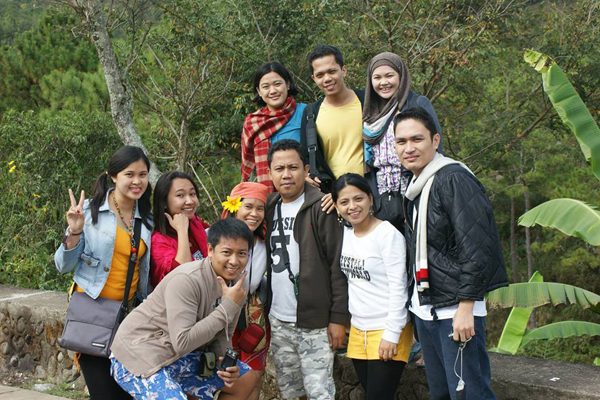
Richelle and her classmates in graduate school spending Christmas at Sagada, Mountain Province in the northern part of the Philippines
In 2011 I spent the Christmas Eve with the girls and Sisters in Holy Family Home, Pembo, Makati City. It was a night of prayers and laughter, a night of singing and hugging, merriment and reconciliation. For each girl in the home it was another night of being with a family, a family where they were being cared for and loved. By this time, I wasn’t a child anymore. But Christmas has its magical effect of bringing out in everyone the simplicity, innocence and joy of being a child once again. No matter where you are or who you are it just comes out naturally for you to be excited in giving and opening gifts, in putting up decorations in your house and in dancing to the beat of songs that we only hear when Christmas approaches.
While the celebration was going on, I suddenly thought about the Sisters. They had offered their lives for the mission. Being with the girls, seeing them grow in faith and making each day for them a day closer to their dreams being fulfilled has been the way of life of the Capuchin Tertiary Sisters of the Holy Family. Holy Family Home is a home of wonderful dreams and a home filled with love. More than any material thing that the Sisters have provided for the girls is the assurance of unconditional love for each of them. More than the diploma the girls could acquire is the Sisters’ deeper desire of educating them in wisdom that they can carry for a lifetime and of values that penetrate not only their own lives but also those who are significant to them and people around them.
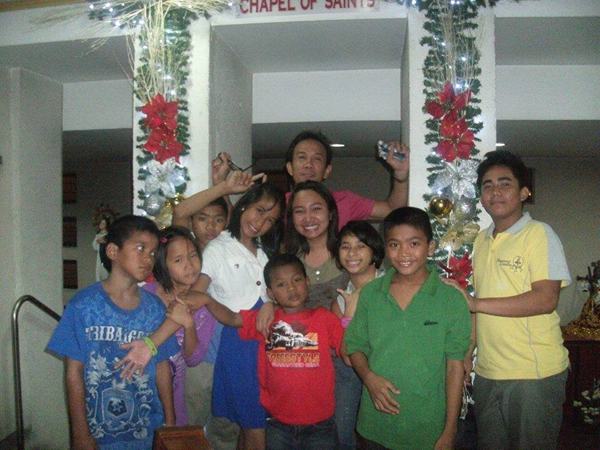
The children and staff of one of the homes of Virlanie Foundation Inc. after
attending a morning mass few days before Christmas
Through the years, people have come and gone, have entered and left the homes of the Sisters.But surely, each girl that they have welcomed is already part of their family forever. Such has made Holy Family Home a true home because the love that the Sisters have for the girls is something that will never be cut anymore. It goes on, and it grows for it is a kind of love coming from God. It transcends time, as though Christmas is really everyday.
Then came last year when I had a different taste of Christmas. I spent it in Sagada, Mountain Province, with nine other people. We were so diverse--- with four Muslims in our group. What made that Christmas different wasn't the spelunking experience in the Sumaguing cave or the hike towards the Hanging Coffin but the actual walk in cold streets on Christmas Eve. We were doing something we had never done before and it made us feel like children. Once more we were greeting strangers happily as we gave them our biggest smiles. Nobody knew us there so we could jump and run in as carefree manner as we wanted.
Holy Family Home girls on their way to an Advent Concert together with the
center's directress,
Sr Luz Maria Buitrago, TC
But this showed us another meaning of Christmas, perhaps a deeper meaning of Christ’s coming to Earth. It showed us that we are all brothers and sisters and all the other factors and factions should not make us different from one another. It was a new place for most of us but all of us felt at home. As we heard the sound of a gong while children danced around burning firewood, I thought of my little angels in Virlanie Foundation where I was working at the time. For sure, they were having a wonderful time too, together with the house parents who sacrificed spending Christmas with their own families to be with these children. Surely, it was all something done with love and because of that love, our souls will witness what faith and mission truly mean.
In my heart, I know that I will always be thankful to God for my little angels and the house parents in Virlanie Foundation, as well as for the Sisters and the girls in Holy Family Home, for those who have been in our neighborhood before and for those new faces in Sagada that we might never see again. They have all taught me that Christmas may come in many shapes, colors and forms, but in the end, these will all speak about our faith in that one special night that has given us Jesus. Then, because of that faith, we are moved into carrying out our purpose in life which is love in action, a purpose we recognize now as our mission.
A Nightmare
(My Sendong Experienced)
By: GINA BUENA L. MAGNO
July 12, 2012
It only took one night for our family to experience a tragic event. Sometimes such events paralyze us and leave us broken and fragile. Many were devastated by the tragic floods caused by Typhoon Sendong. Houses were washed away, lives lost. Thousands, including my family, were victims of the floods. We are all alive, my husband, my 17-year old twins, 25-year old son and me. This is our story.
16 December 2011, Dep.Ed Night . . . I was one of the awardees of the Search for the Ten Most Outstanding Public School Teachers in Iligan City. Though earlier in the night the rain was very heavy the Dep.Ed night celebration continued, the presentations were great, everybody was dancing and joyously exchanging pleasantries with one another. Me? As an awardee I felt proud as did my husband. After the awarding we immediately went home and arrived at our house at Orchid Homes Subdivision, Brgy. Santiago, Iligan City, at 9:20.
I noticed that the rain wasn’t too heavy but the wind was very strong. We went to sleep. I was awakened by the noise outside our house. As I went out to see what was going on I glanced at clock. It was 12:20 midnight, 17 December. I saw no one on the street, so I went back to our bedroom and lay down, but again heard noise all over the neighborhood and a siren. So I hurriedly stood up to check what the commotion all about.
I was shocked. Water was rushing in like a devil ready to take our lives. I called my husband and woke up our sons. In just a few seconds the water was already at knee level. My mind was disturbed with many questions and thoughts. ‘What will I do? What will I do first? Can we be saved? Will we be saved? I have to be strong for my children .I should have presence of mind.’
I told myself, ‘Don’t panic! Everything will be OK’.
But it wasn’t OK. The water now reached my waist. Despite my desire to save important things I had no time to do so. We have to vacate the house because everything inside was already floating. I just grabbed my bag with my wallet inside, my cellphone and my glasses. My husband ordered us to settle in my neighbor’s house with a second floor. But it was 20 meters away and the current was very strong. We had no choice but to climb onto the roof of our own house. The water was still rising very fast and reached our roof. So we had to transfer to the higher roof of a neighbor’s house at the back, with my cousin’s family and two other neighbors, crawling because it was very slippery.
Then very big logs entered the picture, destroying and washing away some of the houses in the subdivision. I can still clearly remember neighbors shouting for help on rooftops when logs crashed into their houses. Then the cries for help just vanished. That was when I cried because I knew that my neighbors, my friends were gone. I could no longer heard their voices or the crying of the children.
Then a deep silence, with only the sound of logs crashing into houses to be heard. I thought it would also be the end of us.
My husband was trying to find a way for us to jump to the other side of the road. I gave instructions to my sons: ‘If mabungkag ning balay atong gitindugan (if our house is destroyed), save yourselves. Don’t think about me kay dako pa kaayo inyong chance mabuhi mo (because you have a better chance of surviving), I know ug unsa man gani mahitabo sa ako ug sa inyong Daddy dili jud mopasagdan sa inyong mga auntie (Whatever happens to me or Daddy, don’t neglect your aunties) both sides. Be good and responsible’.
The side story of this tragedy was that my then 16-year-old twins hadn’t been on good terms for four years, never speaking to each other, I’d tried so many times to patch up their differences but to my dismay nothing worked. So I just waited for the right time where they might be friends again and I never thought, even in my wildest dreams, that a destructive storm would be that right time. In the midst of our fear and anxiety they really showed how much they cared for each other by thinking about each other’s safety. I asked them, ‘Kinahanglan diay mahitabo ni aron magamigo mo ug balik?’ (Does it take something like this for you to be friends again?) And I added, ‘Whatever happens ug mamatay ko or kami sa inyong Daddy (If I or your Daddy and I die), don’t stop loving and caring for each other. You should draw from each other’s strength so that you will survive”
Everybody was praying so hard I even wanted to shout my prayers to make sure I could be heard by God. Thinking that night would be my end, I asked forgiveness for my sins and from those I had sinned against. And I forgave those who had caused me pain, heartaches and trouble. What I thought might be my last words were, ‘Thy will be done.
It seemed that we were just waiting for our deaths. At 2:00 to 3:00 in the morning of 17 December - I was constantly checking the time on my cellphone - the water was still rising but the current wasn’t so fast anymore. But we didn’t know when the water would subside. And if it didn’t we were trapped on the roof where the water was already at ankle level. My husband decided that we should cross to the other side of the road by the electric wire connecting posts. (Electricity had by then been totally shut off). But I strongly disagreed with him because I knew it wouldn’t work. I said to him, ‘Kung mangamatay man gani ta karon dinh dili na to tagbuon atong kamatayon, atong hulaton’ (If we die here nowlet’s not avoid it, let’s wait for it).
So we just stayed where we were and prayed, prayed and prayed because I strongly believed at that time that the only weapon we had was to pray and trust in God and whatever plans He had for us.
And a miracle happened . . . at 4:30 the water started to subside slowly but surely. Praise God, He answered our prayers. All our family were alive, destined to live longer.
The next thing I knew was that the 3-year-old daughter of my close friend and neighbor and the 31-year-old special child of another close friend and neighbor were missing. Their bodies were never found. So many bodies were found trapped in their houses, and others were drowned.
Our house was totally damaged, and everything in it, including appliances, destroyed, I had nothing left. Back to Zero. But still I have to be thankful that God gave us another chance to live. And most importantly, my twins are now friends, talking to each other sharing their ideas. For me that was the best thing that happened toour family, because of the Typhoon Sendong tragedy.
Carols Echoing Angels’ Songs
|
Pope stresses importance of dialogue to Japanese students.
Back from Fiji
What happens now after your FMA in Fiji?I will continue my studies in theology another two years. (Editor’s note: these began last June.)Then I’ll be ordained deacon. Less than three years more. I’m getting nervous. I’m almost there. It’s more of an excitement, can’t wait to reach that stage already. Living in Fiji, I’ve seen my life as a missionary priest. That’s where my choices were affirmed.
Members of the traditional Indian Mandali Catholic prayer group of which Kurt is also a member. At first I thought I was ready for the missions. I had my spiritual year, then philosophy, then theology,not to mention all the exposure trips and the experience of being immersed in different pastoral situations. I tried ‘nibbling’ at it all in to nourish me and prepare me for the journey ahead. But right now, I can really say that nothing will prepare you for missionary life.
My Life In Arko Punla CommunityBy Vera Santos
In this article Vera Santos tells us how her ten years of involvement with AngArko has blessed her. ‘Blessed be the God and Father of our Lord Jesus Christ, the Father of compassion and God of all encouragement,who encourages us in our every affliction, so that we may be able to encourage those who are in any affliction with the encouragement with which we ourselves are encouraged by God’ (2 Corinthians 1:3-4, New American Bible Revised Edition). For the past ten years that I have been a friend and now a volunteer in the Punla Community, I’ve come to realize that one of the most joyful discoveries in my encounter with the Core Members is that in recognizing, affirming and comforting them, I find myself being recognized, affirmed and comforted as well. Let me recount my experiences with Raymond, Jordan, John Paul, Mariflor, Rea, Lala and Benito and why I find peace, joy and comfort when I am in Arko:
Ang Arko ng Pilipinas – Special Friends
Responsible Stewardship in MissionBy Sr Alicia Alambra FMM
‘Build a community of administrative andfinancial leadersin support of pastoral practice to achievethe mission of the Church.’ This is the goal of our work as Business Managers OF the parishes in the Archdiocese of Chicago. Our ParishI working ina parish, St Donatus, Blue Island, Illinois, founded by the Comboni Missionaries in 1909,.that includes few skilled but many unskilled workers, some of them migrants. The former residents were Italian who in recent years left the parish and went west of Chicago. Now about 90 percent of the populace are from Mexico and Guatemala.
The way we were – home to roost
Fatima’s StoryBy Fatima de Castro
Fatima comes to the Mission Office in Manila to do volunteer work. She is the eldest of five siblings. Her father is a seafarer and her mother a housewife. I’m Ma. Fatima de Castro, a Fourth Year college student at St Paul University, Manila. We have a way of life that’s austere and humble. Let me begin my story involvinga friend named Mike. He used to go to this place overlooking Teresa, Rizal, four hours from Manila. There he met an old lady he calls ‘Nanay’ who sellscoffee, snacks and cigarettes to passersby, especially truck drivers who deliver vegetables and meat downtown. She lives in a small crowded spot beside the highway. She never has a long sleep because she’s watching out for customers that might come and buy.
|
|||||||||||||
Christmas in Another Home
By Clarace J. Galeno
The author works at Riyadh, Saudi Arabia as a nurse. She grew up in the parish of Holy Family, in Bacolod City which was run by the Columbans before. Clarace used to be an active member of the Legion of Mary while she was still here. Here she shares her longing for Christmas at home and how she tries to celebrate it in a country that doesn’t believe in it.

Clarace with colleagues as they try to celebrate Christmas in their workplace.
One of the sure ways to uplift a Filipino spirit is to have a thought of Christmas. It is always a positive memory that we all hold dear in our hearts. Mine is no difference, having grown up in a close family that keeps Christmas tradition faithfully. It always brings a smile recalling those 9 morning masses preceding Christmas -It brings a smile to see the Christmas lights in each home, the decors, gifts, and lovely Christmas carols, and the spirit of faith, hope and love that it all evokes. Those were such happy memories to start. Yet, changes do occur.
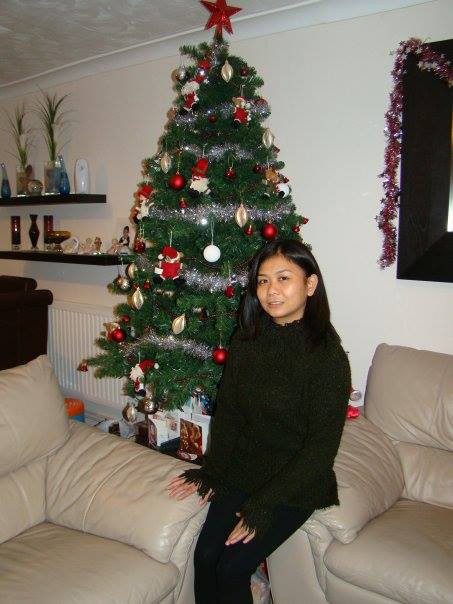 In 2007, I started working as a nurse at the Emergency Department in one of
the hospitals in Riyadh. December is wintertime in the city but I never expected
it to be that cold. I thought Riyadh is a desert country and so it would always
be scorching with dry heat.
In 2007, I started working as a nurse at the Emergency Department in one of
the hospitals in Riyadh. December is wintertime in the city but I never expected
it to be that cold. I thought Riyadh is a desert country and so it would always
be scorching with dry heat.
Winter then was the busiest time in Pediatric Emergency. Most children who were brought in were suffering from various respiratory problems. It was Christmas Eve but I had to work for a night shift duty. Of course, it is not always a happy disposition to work during such time when every Christian would want to spend it with their love ones together instead. The call of duty demanded me to be in the hospital and to do the job. It was really a chaotic night with all those different cases to attend to that I had forgotten that it was already midnight. It was Christmas!
We paused for a while too, greeted one another and shared food. We celebrated in the workplace.
As the days passed by, things have become a routine that our daily encounters seemed to lose sparkle. In an area where stress is part of the job, it became normal to be cynical with all the happenings. It is said that we can see Christ in every person. But personally, it is quite difficult to be confronted daily with a culture so unlike from what I used to. And to see Christ in them? It is a challenge that I posted to myself. It somehow got me through to stay in perspective in dealing with other people. However I could say Divine Providence is more sustaining. By myself I can easily turn negative but the God of Love brings people even the irritating patient or colleague and unfavorable circumstances into an opportunity for growth.
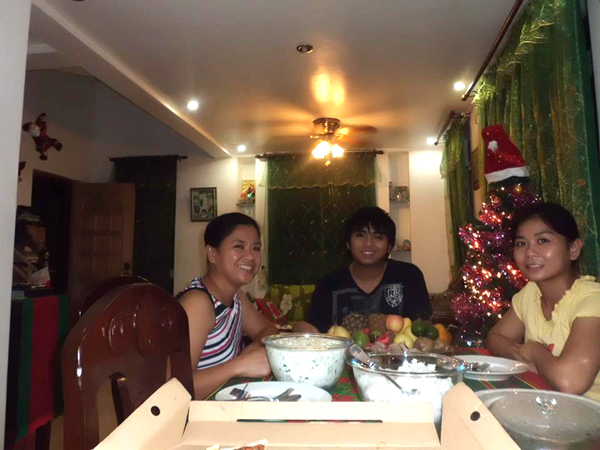
Celebrating Christmas at home
In every decision being made in the workplace, there are a lot of things to consider. Yet above all, it is for the sake of our patients– persons made in the image and likeness of God deserving dignity and care. The idea of being far from home makes me hold on to my roots. The ingrained Filipino Christian value of patience is really tested in instances of petty encounters in an emergency scene. I may complain every once in a while but Jesus never did. I am blessed with good health and the opportunity to work and bless others with what I am doing is something worth thanking for. Being far from home makes me hang on to my faith, to the promise of Christmas that Christ Jesus brings salvation to all of us. It is making me reflect on to the message of Benedict XVI at the Catholic University of the Sacred Heart, Rome on May 3, 2012. He said, “A place in which the relationship of treatment is not a profession out a mission; where the charity of the Good Samaritan is the first seat of learning and the face of suffering man is Christ’s own Face."
A Blessed Christmas to each one of us!!!
Death is stark for the poor
By Sr Mary Dillon SSC
The author is a Columban Sister from Ireland. She has been in the Diocese of Myitkyina, Kachin State, Myanmar (Burma) since 2002. She has developed a home care health program for people with HIV/AIDS and established a respite house, Home of Hope, to enable people from distant places to avail of medical care. Here she reflects on her experience of burials in Myanmar.
I was shocked when I read about the costs of funerals in Ireland. An exorbitant sum was quoted, several thousand euro (€1.00 = PHP58.00), even for a simple, ‘no frills’ burial. Many people it seems spend a long time paying off the debt. Others talked of the cost of a grave, the advantages of cremation, the necessity of a wake or a meal after the burial, and so on. It was all very sobering.

What a contrast to my experience of burials in Myitkyina, Myanmar! For the past nine years here in Myanmar I have been working with the very poor.
In the last year we buried approximately 48 patients from the 30-bed Home of Hope where I am. Most of these, men and women, died of AIDS. The majority had no one to mourn them, no family to grieve at their going.
Some left small children behind them with no one to care for them. All of them had sad stories, sometimes almost unbearable, as they struggled with the disease, especially in their final weeks.
Six years ago we built this Home of Hope, with the help of many benefactors in different countries. Even if I say it myself, it is a lovely place, simple but well-structured, a light-filled space.
We wanted to give the best to the poor who suffer so much in their lives, struggling to eke an existence in a country that is so rich in natural resources, resources to which they have no access.
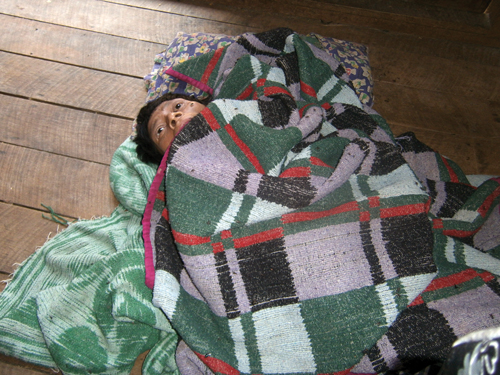
If the sick come in time, even though they have AIDS, they make a good recovery with the help of retro-viral drugs, good, nourishing food and care. Never fully healed, they are nevertheless able to go back to their families with new hope. Many of them live hundreds of kilometers from the Home of Hope so it is a great day when they set out on their journey back.
Over the years, because of the many deaths here, I have learnt a lot about the local burial customs here. First of all, I always have a good supply of wood at hand. When someone dies I tell our handyman, Bwak Naw; he looks at the body, and quickly fashions a simple coffin from plywood boards. The body is then brought in a three-wheeled pedicab (trisikad) to the temple.
After the temple prayers, the coffin is brought to the graveside, accompanied by the relatives (if any are present) and some of the patients. I always go with them. The group are met by the graveyard master before whom the coffin is swung gently to signify submission of the dead person to him. It is then placed on bamboo poles over the grave and the graveyard master walks around it, bending to make chopping movements signifying the severance of the dead from all earthly ties.
The relatives may then sweep a towel over the corpse to gather his/her spirit to take back with them to the home place. When the body is put in the grave the mourners talk to it, telling their relative that he/she is now in a good place with lovely scenery, beautiful trees, rivers and lakes. The earth is then put in. A cross with the name and date of death is placed over every grave, regardless of the religion of the dead person.
After the burial all come back to the Home where, after washing our hands, we partake of coffee and bread. Then the relatives, if any, go back home, often a long journey.
There have been some heartbreaking cases where the only relative is a child. Before I left we had a 38-year-old mother of five children who made a nine-hour train journey to
reach us. Her husband had already died from AIDS. Her eldest daughter, 13-year-old Bwak Ja, traveled with her, leaving the other children at home. Not one of them had ever been to school. The woman was seriously ill and sadly she died after surgery.Alone now, her destitute daughter stood in the Temple as the monks chanted. She stood at the graveside as her mother was put into the grave and wept as the final shovel of earth fell. She had no one at all, no relative, no friend at this terrible time. We took her back to the Home where she stayed for a few days and then I helped her to face her long journey home to join her four orphaned siblings. What future does this child face?
Death is very stark for the poor here in Myitkyina. They have little time to mourn; they must return straight away to eke out a living for their family. You feel their pain, you know their grief, but you know they will get on with life, however wretched their situation.
Survival is the goal. How much does a funeral cost here in Myitkyina? About €100 (PHP5,800). Nobody saves for their burial; somehow it all works out.
Fond Memories Bring the Light
By Fr Niall O’Brien
This article was written by the late Fr Niall O’Brien, founding editor of Misyon for The Visayan Daily Star, a daily newspaper published in Bacolod City, where he had a weekly column. Father Niall died on 27 April 2004.
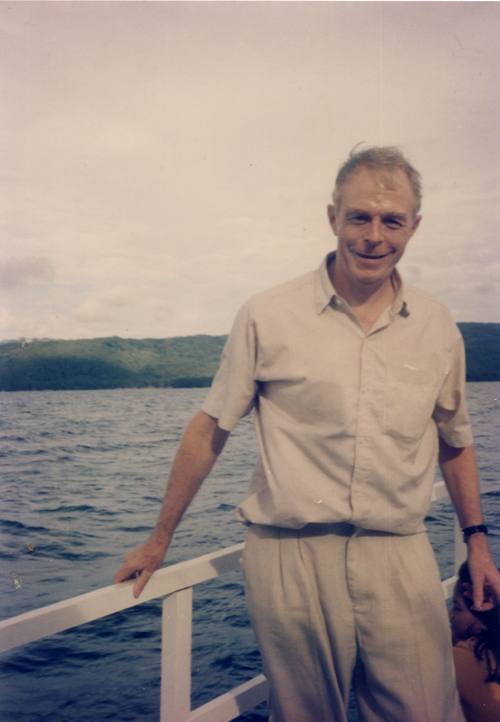 ‘Fond memories bring the light of other days around me.’ So go the words of a 19th century Irish melody by Thomas Moore. That’s the way I feel when I remember Christmas as a child.
‘Fond memories bring the light of other days around me.’ So go the words of a 19th century Irish melody by Thomas Moore. That’s the way I feel when I remember Christmas as a child.
In my family there were strictly no presents given throughout the year, except birthdays and Christmas but particularly Christmas. I had many maiden aunts and bachelor uncles and they added their presents to those of Santa Claus so there was quite a pile waiting for us we new awoke at dawn on Christmas morning.
I recall not being able to sleep with the excitement. My parents could hardly go to bed at midnight before we would wake up. They used to leave three wineglasses and a tiny trace of sherry in the bottom of each glass to show that they had had a drink personally with Santa Claus. That third glass was proof that he had been there and it certainly convinced us.
I recall skating on the road outside our house at 2:30 am on my new roller skates on Christmas morning. I wonder what the tired neighbors thought because roller skates in those days were metal and made a terrible noise.
 Then there was the Mass at 6:00 am. Now that sounds very normal in the Philippines but in Dublin 6:00 am in mid-winter is ‘black midnight. You see we had no Midnight Mass in Dublin because the Archbishop was
afraid of drunken revelers wandering in and causing havoc and his fears were not unfounded. Anyway 6:00 am in December in Ireland is the middle of the night.
Pitch dark except for candles lit in the windows of some houses to guide Mary and Joseph on their way. I wonder does that custom still exist?
Then there was the Mass at 6:00 am. Now that sounds very normal in the Philippines but in Dublin 6:00 am in mid-winter is ‘black midnight. You see we had no Midnight Mass in Dublin because the Archbishop was
afraid of drunken revelers wandering in and causing havoc and his fears were not unfounded. Anyway 6:00 am in December in Ireland is the middle of the night.
Pitch dark except for candles lit in the windows of some houses to guide Mary and Joseph on their way. I wonder does that custom still exist?
Anyway, during the night my father put together an ingenious crib with a star lit secretly by a battery from behind. In our family we never anticipated anything. The crib could only be put up the night before the 25th. Even the Christmas tree could not really be decorated till Christmas Eve. We had old decorations going back to sometime before the late 1940s in Dublin. These were precious relics from a mythical time before the War, when things were said to have been wonderful.
Of course in Ireland our Christmas breakfast was porridge and cream – the porridge cooked during the night – and bacon and eggs and black pudding. (Editor’s note: This is similar to dinuguan but in the form of a large sausage that is sliced and then fried or grilled). In our family we had coffee, not tea, on Christmas morning and my mother ground the beans in an old grinder and the aroma wafted through the house. Then ‘all hands on deck’ to help prepare the Christmas midday dinner. That was the meal of the year.
The centerpiece, of course, was the roast turkey with roast potatoes around it. But there were other things. Ham was de rigeur and in our family we used to have creamed celery for some reason or other that I don’t know. The dessert of course was plum pudding, heavy enough to sink a ship. I am not surprised that nowadays when people bring plum pudding at Christmas through airports they set off the alarms because the sensors thinks that the plum pudding is the explosive semtex. They both have the same density! After lunch you had time to lie around and examine your presents and maybe do a jigsaw together with some member of the family who had got it as a present.
The evening meal was when we opened our presents to each other. My father used to exasperate us all because he would insist on opening the knots with his fingers, never cutting them, and folding the Christmas wrapping paper meticulously before he eventually looked at the present and gave a quiet comment. Not so my mother who attacked hers with zest and gave a cry of joy. ‘That was very thoughtful of you. That was just what I wanted!’
After the evening meal we would sit around the open fire. Alas, open fires are mainly a thing of the past now; central heating has taken their place. The fireplace forms such an intimate focus in the family. You could be lost in your new book but you knew the others were right beside you. In our house we finished the night with the family rosary. For me Christmas day would be ruined if there was the slightest tiff or misunderstanding among us brothers and sister to overshadow the day. I always wanted that day to be perfect. To this day my vision of happiness is still that sense of contentment around the fire in the evening in the heart of the family.
Then came the time when my brother and I, under pressure from our peers, began to doubt the reality of Santa Claus. We decided to confront my mother one lunchtime before we sat down to leat. ‘Mum, is there really a Santa Claus?] We waited expectantly. Considering she had no warning of such a momentous question, she didn’t do too badly. ‘Yes,; she said, ‘there is. But God has made your parents to be Santa Claus’.
When I went to the seminary I had to miss the family Christmas for the first time. That was a Rubicon. I suppose we cannot cling to childhood but the memories are stored away somewhere building up our inner spirit. Today I think how right it was that the mystery of God’s bursting into this world should have been such a day of joy.
Christmas really is a festival for children. Our age has not dealt kindly with children. This Christmas there will be many children in Zambia, the Philippines and East Timor alone, parentless, living in the streets. No parents to be Santa Claus to them.
Christ has given that task to us.
Father Niall refers in his article to a line in a song, Oft, in the Stilly
Night, by
Thomas Moore (1779 – 1852). The recording by Irish tenor
John McCormack (1884 – 1945) is the version that he would have
been most familiar with.
Oft, in the stilly night by Thomas Moore
Oft, in the stilly night,
Ere slumber's chain has bound me,
Fond memory brings the light
Of other days around me;
The smiles, the tears,
Of boyhood's years,
The words of love then spoken;
The eyes that shone,
Now dimm'd and gone,
The cheerful hearts now broken!
Thus, in the stilly night,
Ere slumber's chain hath bound me,
Sad memory brings the light
Of other days around me.
When I remember all
The friends, so link'd together,
I've seen around me fall,
Like leaves in wintry weather;
I feel like one
Who treads alone
Some banquet-hall deserted,
Whose lights are fled,
Whose garlands dead,
And all but he departed!
Thus, in the stilly night,
Ere slumber's chain has bound me,
Sad memory brings the light
Of other days around me.



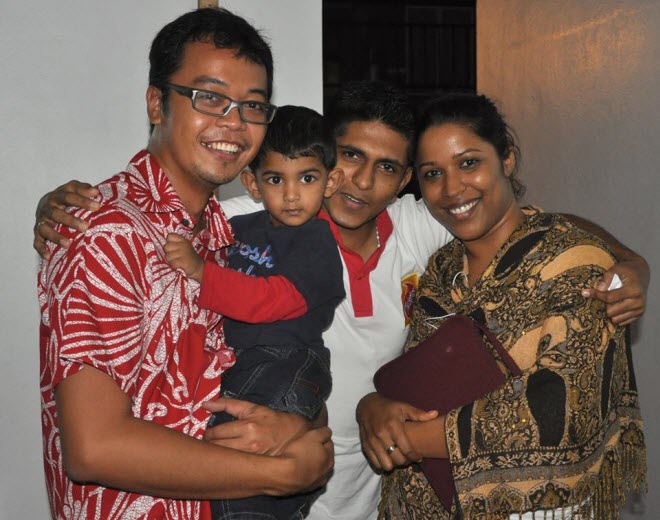
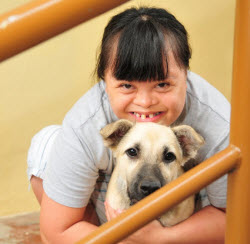
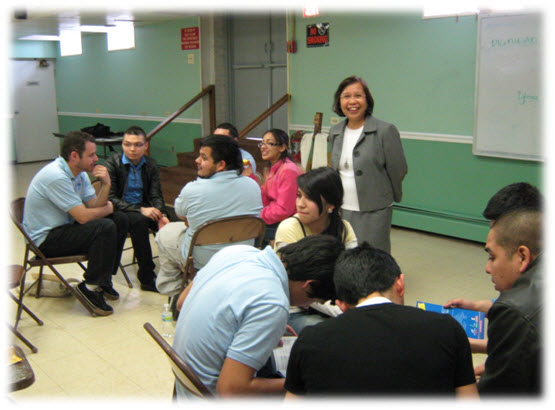





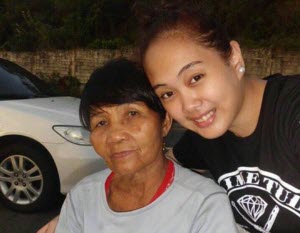 I went to this place with Mike to relax, enjoy the view of the sunset and of Laguna de Bay and also meet Nanay. The first time I saw her, I felt sad and pitied her because she was on her own. Her husband is always drunk and she can’t depend on him. They have no electricity so theydepend only on a lamp. No gas stove, just a grill. Mike gave her a cellphone with a load so that the three of us could keep in touch.
I went to this place with Mike to relax, enjoy the view of the sunset and of Laguna de Bay and also meet Nanay. The first time I saw her, I felt sad and pitied her because she was on her own. Her husband is always drunk and she can’t depend on him. They have no electricity so theydepend only on a lamp. No gas stove, just a grill. Mike gave her a cellphone with a load so that the three of us could keep in touch.